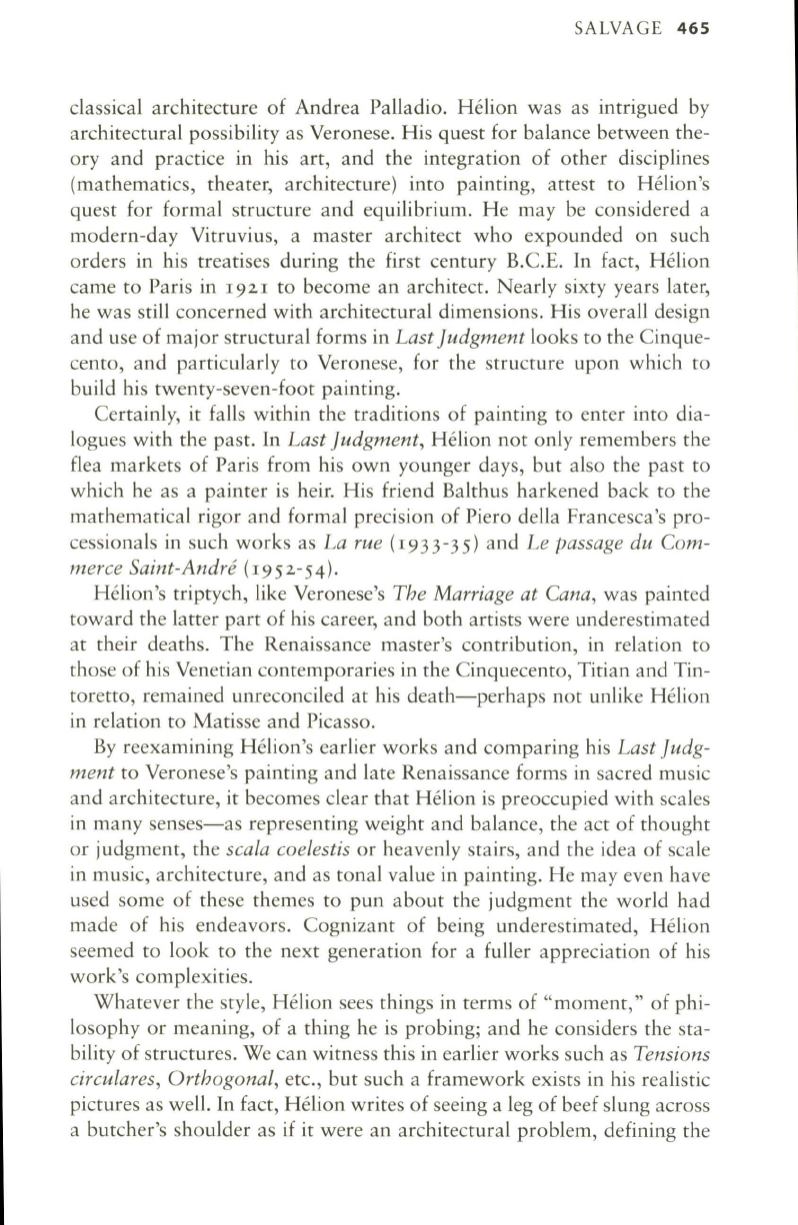
SALVAGE
465
classical architecture of Andrea Palladio. Helion was as intrigued by
architectural possibility as Veronese. His quest for balance between the–
ory and practice in his art, and the integration of other disciplines
(mathematics, theater, architecture) into painting, attest to Helion's
quest for formal structure and equilibrium. He may be considered a
modern-day Vitruvius, a master architect who expounded on such
orders in his treatises during the first century B.C.E. In fact, Helion
came to Paris in 1921 to become an architect. Nearly sixty years later,
he was still concerned with architectural dimensions. His overall design
and use of major structural forms in
Last Judgment
looks to the Cinque–
cento, and particularly to Veronese, for the structure upon which to
build his twenty-seven-foot painting.
Certainly, it falls within the traditions of painting to enter into dia–
logues with the past. In
Last Judgment,
Helion not only remembers the
flea markets of Paris from his own younger days, but also the past to
which he as a painter is heir. His friend Balthus harkened back to the
mathematical rigor and formal precision of Piero della Francesca's pro–
cessionals in such works as
La rue
(1933 -35) and
Le passage du Com–
merce Saint-Andre
(1952-54).
Helion's triptych, like Veronese's
The Marriage at Cana,
was painted
toward the latter part of his career, and both artists were underestimated
at their deaths. The Renaissance master's contribution, in relation to
those of his Venetian contemporaries in the Cinquecento, Titian and Tin–
toretto, remained unreconciled at his death-perhaps not unlike Helion
in relation to Matisse and Picasso.
By reexamining Helion's earlier works and comparing his
Last Judg–
ment
to Veronese's painting and late Renaissance forms in sacred music
and architecture, it becomes clear that Helion is preoccupied with scales
in many senses-as representing weight and balance, the act of thought
or judgment, the
scala coelestis
or heavenly stairs, and the idea of scale
in music, architecture, and as tonal value in painting. He may even have
used some of these themes to pun about the judgment the world had
made of his endeavors. Cognizant of being underestimated, Helion
seemed to look to the next generation for a fuller appreciation of his
work's complexities.
Whatever the style, Helion sees things in terms of "moment," of phi–
losophy or meaning, of a thing he is probing; and he considers the sta–
bility of structures. We can witness this in earlier works such as
Tensions
circulares, Orthogonal,
etc., but such a framework exists in his realistic
pictures as well. In fact, Helion writes of seeing a leg of beef slung across
a butcher's shoulder as if it were an architectural problem, defining the


